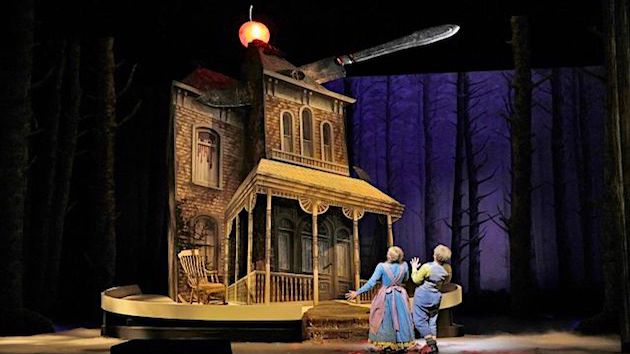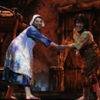
Not to take away from the appreciation of vocal and orchestral performances, it is possible to come away from the San Francisco Opera’s Hansel and Gretel humming the sets.
Antony McDonald’s staging and production design, a coproduction with The Royal Opera Covent Garden, is spectacular, from the Black Forest approximation of The Sound of Music’s alpine meadow to the witch’s house and its rocket-launcher-sized mixing bowl serving as the witch’s final destination.
The opening scene is especially impressive, with a seamless combination of a magnificent scrim of the valley scene and the actual structure of the mountain cabin where the children live. Animals and fairy-tale figures populate the stage throughout the production.

Engelbert Humperdick’s fairy tale opera has had a curious history here. Following the 1893 premiere in Weimar and the first U.S. production, at the Metropolitan Opera in 1905, San Francisco Opera presented Hansel and Gretel in 1929 in the New Dreamland Auditorium — this was three years before the War Memorial opened.
Shows followed in quick succession: 1930 and 1932, but then 70 years passed before the 2002 Richard Jones production (with Graham Clark as the unforgettable Witch), and then another 17 H&G-free years until now.
On Friday, under Christopher Franklin’s baton, the hour-long combined first and second acts sounded unusually slow (an observation, not an objection). Tempo and volume picked up after intermission for the third and fourth acts, which took only 42 minutes, when Robert Brubaker’s cannibalistic Witch ruled over the proceedings.

Sasha Cooke (Hansel) and Heidi Stober (Gretel), Michaela Martens (Mother) and Alfred Walker (Father) all bring distinguished records with SF Opera and voices even more powerful than required for the Humperdinck: Martens and Walker sang together in the company’s outstanding Elektra, she as Klytemnestra and he as Orest.
Cooke, also busy at SF Symphony, has sung the title roles in Handel’s Orlando and Mark Adamo’s The Gospel of Mary Magdalene; Anna in Les Troyens; and Magdalene in Die Meistersinger von Nürnberg. Stober has impressed in a wide range of roles, including Zdenka in Arabella; Angelica in Orlando; Johanna in Sweeney Todd; Norina in Don Pasquale; and Magnolia Hawks in Show Boat.

The voices were well-balanced, and stage action uniformly fine, although Stober unexpectedly out-sang Cooke at times. Brubaker, yet another Elektra veteran (Aegisth), also had roles in Manon and Turandot, but nothing as major as the Witch, with her/his big aria, the “Hexenlied” — but as the opera is sung and supertitled in English, let’s call it the “Witch’s Song.”
Adler Fellows Natalie Image and Ashley Dixon contributed well to the performance, as the Dew Fairy and the Sandman, respectively.
For the all-too-brief final scene, the stage was crowded by children recovering from their gingerbread state, members of the SF Girls and SF Boys Chorus, singing their hearts out.

McDonald de-emphasized the work’s scary aspects, saying that “I have tried to approach it as a simple fairy story. It is set in Germany, but it is not realistic — it is magical! I have allowed the themes of the piece — hunger, abusive parents, greed and, finally, good triumphing over evil — to play themselves rather than be heavily underlined. I appreciate that this is an opera that very often is the first that many children see and therefore wanted it to be visually arresting and engaging, creating a balance of fear and delight.”
Along with Opera San José, SF Opera is offering Hansel and Gretel as a holiday attraction, vying with Nutcracker, Messiah, A Christmas Tale, and others. In San Francisco, the drive to attract children provides a discount on tickets, and includes such activities as gingerbread hunts, character meet-and-greets, and exploration workshops for families.





